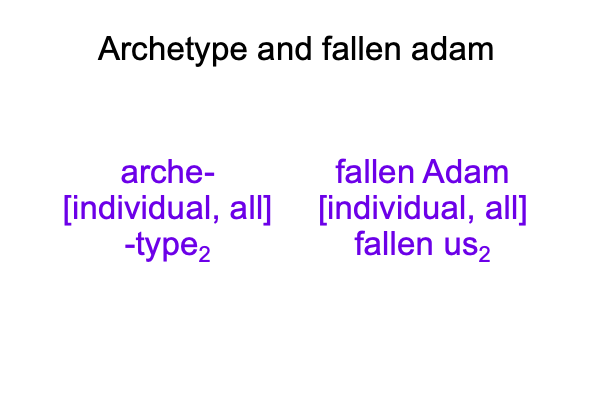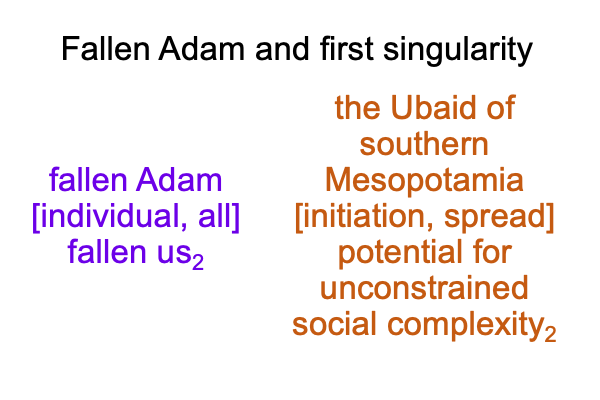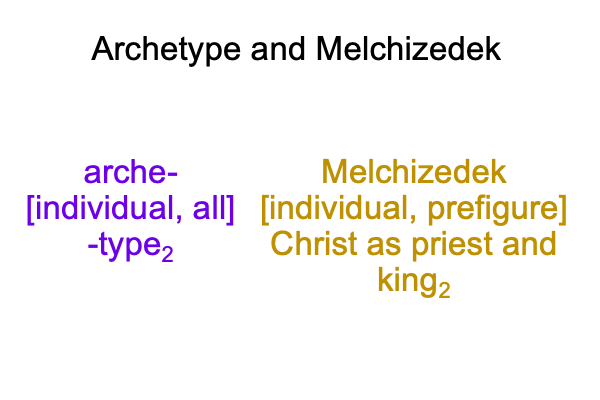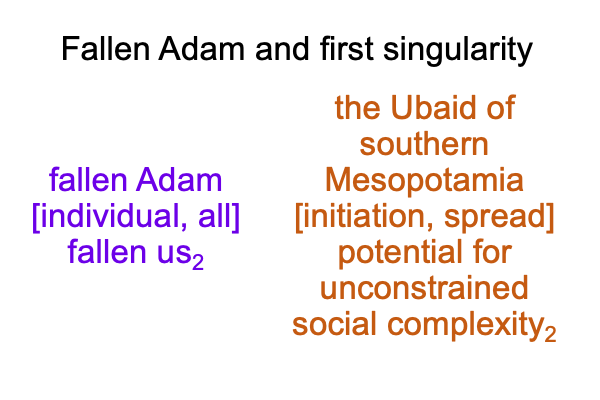Looking at John Walton’s Book (2015) “The Lost World of Adam and Eve” (Part 10 of 22)
0088 What is proposition nine?
The formation of Adam and Eve at the start of the Primeval History as a lot in common with other origin stories of the ancient Near East.
In short, they all are archetypal.
0089 I have already noted that the archetype works as a hylomorphe. “Arche-” means “original”. “-Type” means “imprint”. The contiguity is both individual and all.
The wordplay in Genesis is instructive. There are two real elements, a person (“Adam”) and all humans (“adam”). But, once “Adam” is created, then “adam” is not simply all humans. “Adam” is us, humans in our current Lebenswelt.
Here is a picture.
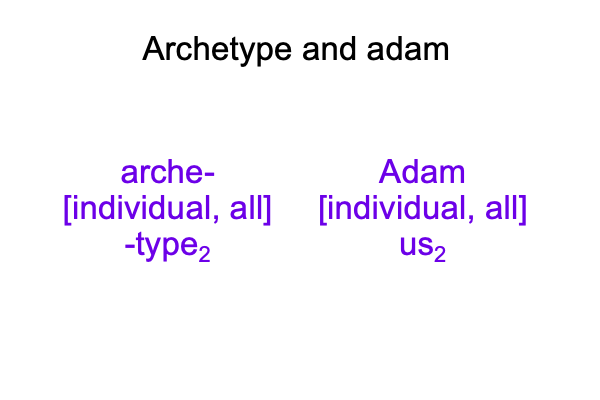
0090 “Us” means “all of us” means “all humans in our current Lebenswelt”.
Once Adam and Eve leave the Garden of Eden, there is no going back.
Similarly, once a culture adopts speech-alone talk, then they travel a one-way street to our current Lebenswelt.
This includes the Ubaid of southern Mesopotamia, the first culture to practice speech-alone talk.
0091 The stories of Adam and Eve begin with a second creation of humans. This second creation is recent. There is no indication (except in the prior Creation Story) of humans living prior to the second creation. Perhaps, in the Garden of Eden, there are clues to a deep past. But, the storyteller cannot see past the first singularity. The storyteller cannot envision the Lebenswelt that we evolved in.
0092 Walton considers eleven literary works from the ancient Near East. They appear on cuneiform tablets, as noted earlier. These works come from Sumer, Akkad and Egypt. Each tells the origin of humans.
They all have one feature in common. They cannot see far back in time. The creation of humans is a recent affair, performed by fully differentiated gods, often using tools in an organizational framework. For example, some stories tell of humans springing like plants from the soil.
0093 Why do all the origin stories of the ancient Near East, including the Primeval History in Genesis, portray a recent creation of humans?
Such is the nature of the first singularity.
Once a hand-speech talking culture adopts speech-alone talk, or comes into contact with a culture practicing speech-alone talk, it tends to drop the hand-component of its hand-speech talk. The semiotic qualities of speech-alone talk are radically different than hand-talk, so cultural memories held in hand-speech talk traditions are soon forgotten. It only takes a few generations.
0094 The Ubaid loses its memory of the cultures that fused to create it. Similarly, the Akkadians and the Egyptians, early adopters of speech-alone talk, cannot remember their once-timeless hand-speech talk traditions. Those old traditions don’t make sense. They don’t translate into speech-alone talk. So, features are dreamily re-configured in order to depict what must have happened.
Why does the name of the Egyptian wise man, “Adapa”, sound like the name of the first human in Genesis, “Adam”? There are many weird coincidences between the eleven origin stories that Walton discusses and the stories in Genesis 1-11. These coincidences point to fluid conditions, where storytellers attempt to codify events and processes that are (1) evolutionarily recent, (2) unpredictably novel and (3) utterly confounding.
Speech-alone talk potentiates unconstrained social complexity. Labor and social specialization spontaneously manifest, for no apparent reason. Innovations cannot be rationalized, so they must be gifts from the gods. What human, in right mind, would invent the wheel or writing or irrigation or ziggurats? They are all spontaneously created as speech-alone words produce artifacts and the produced artifacts validate the meanings of the spoken words. How crazy is that? Er… I should ask… how stable is that?
0095 In contrast, the hand-speech talking cultures of the North American Plains Indians and the Australian Aborigineshave memories in deep time. The dance circles and the dreamtime are timeless hand-speech talk traditions.
But, like all previous hand-speech talking cultures who encounter civilization, these cultures are rapidly losing the hand-component of their hand-speech talk. These cultures are adopting speech-alone talk. They are now immersed in speech-alone talking civilizations, whose members imagine that, because they are wealthier (labor specialization) and more powerful (social specialization), they represent a superior way of life.

